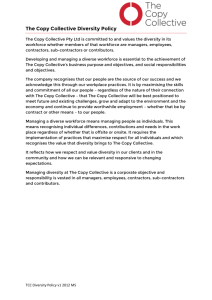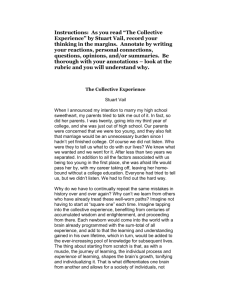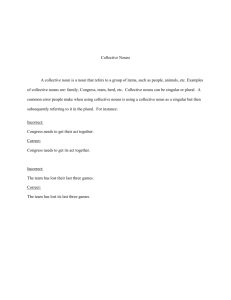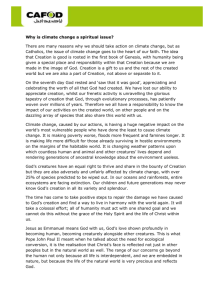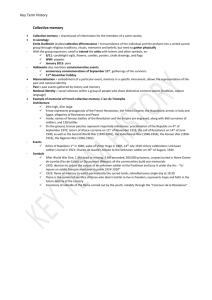Science of CI: Resources for change
advertisement
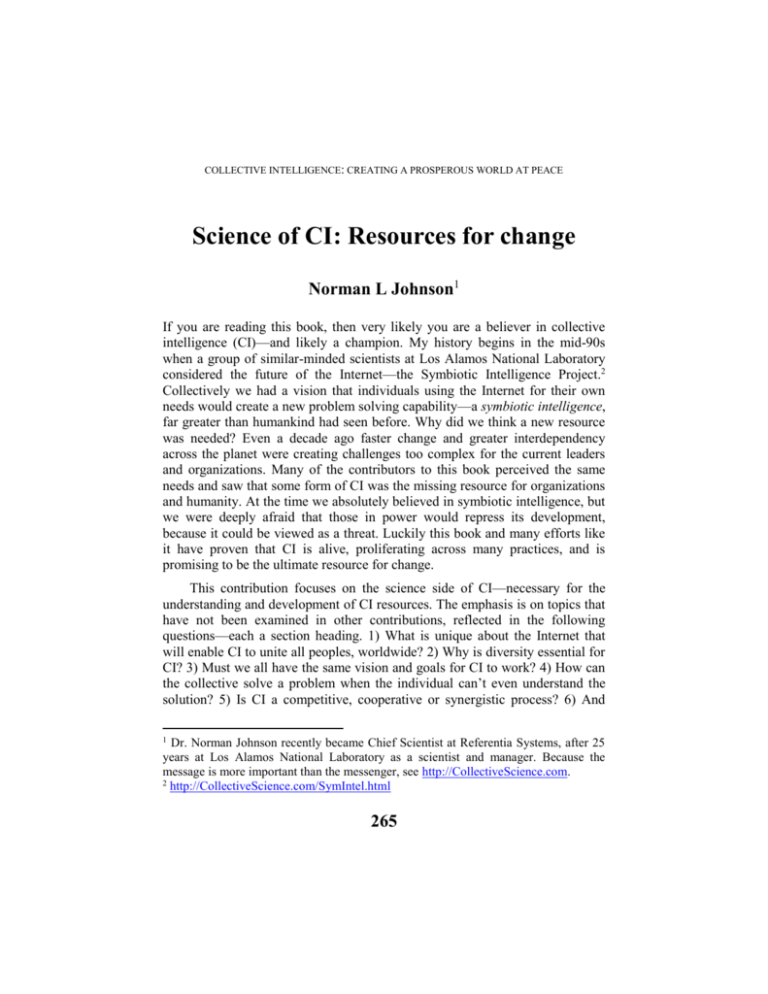
COLLECTIVE INTELLIGENCE: CREATING A PROSPEROUS WORLD AT PEACE
Science of CI: Resources for change
Norman L Johnson1
If you are reading this book, then very likely you are a believer in collective
intelligence (CI)—and likely a champion. My history begins in the mid-90s
when a group of similar-minded scientists at Los Alamos National Laboratory
considered the future of the Internet—the Symbiotic Intelligence Project.2
Collectively we had a vision that individuals using the Internet for their own
needs would create a new problem solving capability—a symbiotic intelligence,
far greater than humankind had seen before. Why did we think a new resource
was needed? Even a decade ago faster change and greater interdependency
across the planet were creating challenges too complex for the current leaders
and organizations. Many of the contributors to this book perceived the same
needs and saw that some form of CI was the missing resource for organizations
and humanity. At the time we absolutely believed in symbiotic intelligence, but
we were deeply afraid that those in power would repress its development,
because it could be viewed as a threat. Luckily this book and many efforts like
it have proven that CI is alive, proliferating across many practices, and is
promising to be the ultimate resource for change.
This contribution focuses on the science side of CI—necessary for the
understanding and development of CI resources. The emphasis is on topics that
have not been examined in other contributions, reflected in the following
questions—each a section heading. 1) What is unique about the Internet that
will enable CI to unite all peoples, worldwide? 2) Why is diversity essential for
CI? 3) Must we all have the same vision and goals for CI to work? 4) How can
the collective solve a problem when the individual can’t even understand the
solution? 5) Is CI a competitive, cooperative or synergistic process? 6) And
1
Dr. Norman Johnson recently became Chief Scientist at Referentia Systems, after 25
years at Los Alamos National Laboratory as a scientist and manager. Because the
message is more important than the messenger, see http://CollectiveScience.com.
2
http://CollectiveScience.com/SymIntel.html
265
COGNITIVE BIAS AND CROWD WISDOM
finally how does CI fit into traditional models of leadership? A science
perspective provides much-needed tools for understanding the workings of CI
and establishing a foundation for the next generation of CI resources.
1. Symbiotic Intelligence: The Future of Humans and IT systems3
As many contributors to this book observed, CI is not new—in fact, every
social organism from slime molds to social insects to social primates have
evolved social structures and the supporting dynamics which enable them to
"solve" problems that threaten or limit their existence. What is new is that these
CI processes, and new ones yet to evolve, are now applied at unimaginable
scales (numbers and spatial extent) than previously observed. This is significant
because self-organizing social organisms are observed in nature to have an
upper limit in size and extent. For example, beehives will divide into two parts
upon reaching a critical number, because above this size the performance of
self-organizing processes decline. The cells in a heart above a certain volume
cannot coordinate beating, and a heart attack is likely. Even the development of
human languages may be driven by the size of the self-organizing social
structure, as in India where 100s of incompatible languages occur even without
geographic boundaries.
What is unique about the Internet that enables larger numbers over greater
extent to self-organize? The Internet has three significant, arguably unique,
capabilities beyond prior human-technology systems: 1) breadth—the ability to
connect quickly, globally heterogeneous systems, 2) depth—the ability to
capture and retain details of the access and use of information and 3)
accuracy—the ability with minimal loss to relate and transmit information. All
of the modern implementations of CI on the Internet exploit these unique
capabilities. For example, the Amazon’s product referral system requires rapid
access to detailed purchasing histories of individuals (and not bestseller
aggregations) with no loss of information. The same is true for Google’s
recommender system. These unique capabilities overcome the prior thresholds
of size and extent previously observed in human-technology systems. And it
captures knowledge that was previously lost: when you retrieve a reference
from a book on our shelf, only you benefit from it—on the Internet, all can
benefit from it. It is fortuitous that the same Internet that created the global
challenges of faster change and greater interdependence also provides humans
3
IT – Information Technology, see http://CollectiveScience.com/SymIntel.html
266
SCIENCE OF CI
with the resources to meet these challenges. Or maybe it is not fortuitous –
contingency planning is observed routinely in self-organizing systems that
continually create innovations!
2. Collective Intelligence: Diversity, Diversity, Diversity
Other contributors to this book have documented how collectives can
outperform the average individual and often the expert. Fig. 1 illustrates
graphically the relative utility of the individual and the collective (the figure is
modified from a book that examines CI in finance4). If the problem is simple,
all individuals solve the problem well. But as complexity increases, the expert
typically has skills or information that increase their utility. At some threshold
of complexity—a complexity barrier—even the experts (or groups or
organizations, depending on the scale of the problem) are challenged and their
utility declines. The notional curve for the collective captures why many think
CI is important. But under what conditions does the collective have utility and
what are the limits?
Utility
Complexity Barriers
Expert
Collective
Expert
Collective
Simple
Problem Complexity
Complex
Figure 1: The utility of the expert and collective with increasing complexity
In 1998, this author did an extensive study5 of how the combined
information from a collective of independent individuals can solve a hard
problem—a maze—better than the average individual and often better than the
4
Mauboussin, M. J. (2006). More than you know: Finding financial wisdom in
unconventional places. New York: Columbia University Press.
5
Johnson, N. L. (1998). Collective problem solving: Functionality beyond the
individual. http://CollectiveScience.com/Documents_1/NLJsims_AB_v11.pdf
267
COGNITIVE BIAS AND CROWD WISDOM
best individual in the group. An analysis found that this CI performance
correlated with the uniqueness of each individual contribution to the collective
information or, in general, the diversity of the individual contributions. In fact,
the study found that diversity, even in performance, was more important than
having the best performers in the group. This conclusion reflects the intuition
and empirical studies captured in many chapters of this book where diverse
groups solve problems better than experts—for complex problems, as reflected
in Fig. 1. This result was so unexpected that a reviewer of this paper stated in
1998, “I don’t see what is wrong, but it can’t be right.” Some good ideas are
before their times.
A familiar example captures how this form of CI occurs. We all have
observed that ants have a remarkable ability to find the shortest path between
the dropped potato salad and their nest and that they use their pheromone trails
(not their odometers or GPS units!) to accomplish this. Suppose that every ant
took the same, non-optimal path initially between the food and the nest. Of
course, this collective can only find one path—the wrong one, so it is easy to
see that a diversity of path solutions is essential for the ants to find the shortest
path. The maze study discovered that when the collective finds the shortest path,
no one individual is actually taking that shortest path. Instead, the collective
shortest path is a composite of diverse individual contributions. In the ant
foraging, only later does one ant and all take the shortest path.
In the maze study, the CI of the group was also found to decline as either
the individual performance declined or as the complexity of the problem
increased. A way to view this is that the collective solution amplifies the weak
signals of the individuals. If the problem is too complex, individuals only
contribute noise, and the CI is not observed. The collective curve in Fig. 1
captures these conclusions. If the problem is simple, any individual can solve
the problem so there is no utility in CI. But as the problem becomes more
complex, the individual is challenged by the individual complexity barrier and
requires CI to find the optimal solution. And finally, if the problem is too
difficult, then even the collective hits a “collective” complexity barrier, and the
utility of CI declines.
Scott Page in his book, Differences6, captures these results in a general
“diversity prediction theorem” (a rearrangement of the variance theorem):
6
Page, S. E. (2007). The Difference: How the power of diversity creates better groups,
268
SCIENCE OF CI
Collective error = {Average individual error}—{Prediction diversity}
This theorem illustrates the importance of diversity in the CI solutions.
The collective error is reduced as the prediction diversity increases. And why
the collective utility declines as the complexity increases: if the individual error
increases as the complexity increases, then the collective error also increases.
These are powerful conclusions about the utility of CI.
3. Compatible Worldviews—A Requirement for CI Synergy
While diversity of the individuals is the primary requirement of the selforganizing CI, another requirement is that the diverse contributions must be
compatible. Many facilitators can relate horror stories how major conflicts arise
in groups that are “too” diverse. This requirement is often captured as: the
individuals agree on goals or objectives. Certainly this is one way to achieve
compatibility, but in a complex world where individuals come together with
different starting and ending points, a less restrictive requirement is essential. In
the maze study discussed above, the conclusion was that compatibility is only
required at the decision points where diverse information is combined.
A simple example of this is the foraging ants. Suppose there are multiple
food sources that are sufficiently close such that part of the optimal path
overlaps. In this example, even though the goals (food sources) may be
different, the ants can benefit from the commonality in parts of the path. The
human equivalent is commonly called the “water cooler effect”: how often do
you run into someone that has exactly the piece of information you need for
your problem, often by accident, even though your savior does not have the
same goal as you. Something to consider: is it possible that it’s not an accident,
and our gregariousness is designed to make this magic happen?
A way to capture this common “worldview” is to agree on options at each
decision point. This does not mean that every individual must have the same
preferred option, just that they agree on the set of options. When two
individuals have a different set of options, then the options that are not common
often become the source of conflict. As many facilitators know, often restating
the problem (and creating a different decision path) can create worldviews that
are compatible. For example, consider the following two problem statements.
Unwanted births can be achieved by terminating pregnancy. Healthy
teams, schools, and societies. Princeton, NJ: Princeton University Press.
269
COGNITIVE BIAS AND CROWD WISDOM
communities value all their members. The first leads to an immediate
disagreement on options, while the second invites synergy of ideas.
4. Sweet Spot of CI: Between Competition and Cooperation
The main reason that the many believe that a diverse collective cannot
outperform an expert is because the dominant paradigm for group performance
is from competitive processes: competition between smart individuals finds the
best solution—the social equivalent of Darwinism. Doesn’t your organization
hire the best and reward the top performers? So it is unthinkable that a diversity
of individual performance is preferred over a team of high performers. Yet,
every manager that I’ve met can relate an instance where magic happened in a
diverse team. Part of the answer to resolving this conflict between paradigms
lies in Fig. 1: for problems of moderate complexity, engage the expert to solve
the problem, but as the complexity increases beyond the ability of the expert, a
diverse collective is needed to solve the problem. But here’s the problem: we
think the way to get a diverse collective working well together is through
cooperation. But many contributors of this book warn of the hazards too much
cooperation: group-think and herd mentality. Herein lies the challenge: how are
the different collective performance paradigms related and how does a group
transition from competitive to cooperative?
In studies of self-organizing systems7, three different mechanisms for
collective performance are observed and typically are sequential in a
developmental process: 1) Formative: the group improves by the improvement
of individual performance via competitive processes, 2) Synergistic: the group
improves by the synergy of individual differences via the diverse CI processes
discussed above, and finally, 3) Condensed: the group converges on an optimal
solution, through cooperation and often codification. In the ant foraging
example and in Fig. 1, all stages are captured. For moderate complexity
problems, individuals can competitively solve their local path problem, while
the collective “synergistically” discovers the global optimal path, and later most
individuals “condense” to the best collective solution. For simple problems, one
ant finds the best solution, and the collective condenses to this one solution—
7
Johnson, N. L. (2002). The Development of Collective Structure and Its Response to
Environmental Change. S.E.E.D. Journal, 2 (3), 84–113.
http://www.library.utoronto.ca/see/SEED/Vol2-3/2-3%20resolved/Johnson.htm
270
SCIENCE OF CI
the synergistic stage is skipped. Or for difficult problems, the synergy of the
diverse group may never occur and the system will remain in the first stage.
The above reinforces the earlier guidance of matching the performance
processes to the complexity of the problem. The developmental view of selforganizing systems provides additional guidelines: 1) collective performance
develops in predictable stages—enable rather than fight these—for example, if
the problem is challenging for the individuals, then competitive processes may
dominate even when synergistic or cooperative processes are desired,
2) increasing rates of change (a type of complexity) will force a self-organizing
collective to earlier developmental stages, 3) in dynamic environments the
performance and robustness of the synergistic stage is a sweet spot and,
4) beware of the lack of robustness of the optimized, low-diversity condensed
stage.
5. Emergent CI: When the Individual Is Clueless & the Is Collective Smart
Many of the above science-based concepts of CI are intuitive and are aligned
with the observations found in other chapters. But there is also an aspect of the
above studies that is profoundly challenging, yet at the same time, possibly the
greatest potential of CI. Again, we use the ant foraging example to illustrate the
concept of emergent CI. As mentioned earlier, the collective finds a shortest
path even though an individual does not have the resources to know if their path
is optimal or even better. In essence, the individual is contributing to a global
collective solution—the shortest path—that cannot be understood by individual.
This is a classic example of an emergent property commonly used in
complexity studies: when a global property cannot be determined from
knowledge of the components. In the foraging examples, the shortest path is an
emergent property. But because the individuals cannot comprehend a shortest
path, these systems also express emergent problem definition, where even the
global problem definition is not understood at the individual level.
Some examples of human emergent problem definition and solution are
illustrative. The first example is the Bali water distribution system8 where along
a typical river, small groups of farmers meet regularly in water temples to
locally manage their irrigation systems. What is remarkable is that the
8
Lansing, J. S. (2006). Perfect order: Recognizing complexity in Bali. Princeton, N.J.,
Princeton University Press.
271
COGNITIVE BIAS AND CROWD WISDOM
distribution of water is globally optimized by these local rituals to large
changes in the total water flow, ensuring water for everyone along the river.
Interestingly, there is no evidence that the local rituals were planned to have
global optimization. While it is an outstanding research problem of how such
an emergent CI system evolves, the two essential observations are that 1) by
each group focusing on their own problem, the system self-organizes to a
global optimum—to the benefit of all and 2) the local groups are not aware of
the global optimization, although all the groups of farmers benefit from this
emergent CI. A second example is the fall of Berlin wall—one that caught the
world by surprise. It was not predicted, nor was it planned in any localized
sense: the individuals that participated in the process that led up to the event
never had that goal, nor knew that this was a possible outcome of their
activities. It just happened as an emergent CI solution to a collective problem.
There are likely many examples of emergent problem definition and solution in
the history of humans, but because historians are not generally appreciative of
CI, these emergent CI solutions are attributed to individuals.
6. Leadership and Collective Intelligence
Collective intelligence is a threatening concept to many leaders: how can a
leader be a leader if they defer their intelligence to the collective? One way of
packaging CI so that it is more acceptable is to capture it as another form of
leadership. This repackaging of CI has proven to be readily digestible to a wide
variety of particularly diehard leaders, such as physicians and scientists,
possibly because traditional forms of leadership are being challenged and the
availability of more powerful resources for leadership is attractive, if not
essential. The following builds on the concepts discussed above.
Many lament the lack of clarity in the field of leadership, for example,
Cecil Gibb: "The concept of leadership has largely lost its value for the social
sciences, although it remains indispensable to general discourse."9 To stay
above this swamp the approach taken here is to observe the broad shifts in
leadership theories:10 1) the shift of the basis of leadership from power or
Gibb, C. (1968). “Leadership: Psychological Aspects.” International Encyclopedia of
the Social Sciences. D. L. Sills. New York, Macmillan. 9, 91-101.
10
Hazy, J. K., J. A. Goldstein, et al. (2007). Complex Systems Leadership Theory: New
Perspectives from Complexity Science on Social and Organizational Effectiveness.
Mansfield, MA 02048, ISCE Publishing.
9
272
SCIENCE OF CI
structure (sustaining a leadership position by rules) to performance and 2) the
shift from localized leadership to more distributed leadership. Two conclusions
directly result, respectively: 1) leadership should include all processes that lead
to higher performance—specifically CI, and 2) CI is the best framework to
Emergent
Leadership
How
Leadership
Arises:
Degree of
emergence
Q2: Classic,
opportunistic,
localized
leadership
Q4: Emergent
collective
leadership
Q1: Classic,
structured,
localized
leadership
Q3: Structured
collective
leadership
Structure-based
Leadership
Localized
Distributed
Where Leadership Is Located:
Degree of distribution
understand distributed leadership.
Figure 2: A Leadership Landscape with CI included (right column)
To capture the intersection of CI and leadership, a landscape, as in Fig. 2,
is defined11 with one axis being “How leadership arises: degree of emergence”
and the other “Where leadership arises: degree of distribution.”
The degree of distribution is the number of individuals required for a
leadership decision (the emphasis is on the decision and not the execution of
the decision) and ranges from one for a single leader to the entire group.
Johnson, N. L. and J. H. Watkins, “Emergent Collective Leadership: The Next
Frontier of Decision making”, in progress
11
273
COGNITIVE BIAS AND CROWD WISDOM
A quantitative measure for emergence is challenging at best and is a
controversial topic of research. For the current context, the degree of emergence
is defined as the difference between the number of flexible, synergistic, or
unpredictable interactions needed for the leadership decision minus the number
of prescribed interactions supporting the decision, all divided by the sum of
these two numbers.
This emergence metric ranges from -1 for rigid, rule-based leadership to a
number approaching +1 for highly emergent leadership. For simplicity, as in
Fig. 2, the landscape is divided into four quadrants. The quadrants Q1 and Q2
represent respectively the classical types of leadership: localized power or
structure and emergent leadership as in a hero. The quadrants Q3 and Q4
capture the two extremes of CI: the structural-based CI12 such as democracies
or information-enabled CI to the emergent forms of CI discussed above.
This leadership landscape is an ideal framework to summarize the sciencebased CI discoveries presented in this chapter. We began with research on how
the synergy of humans and the Internet may solve the hardest problems facing
humanity, captured by the CI leadership resources (Q3-Q4) in Fig 2. We then
found that diversity is the essential requirement for CI performance. Therefore,
as leadership resources move to the right of the landscape, diversity of the
collective must be developed and expressed, and “leaders” will become
facilitators of the collective wisdom. We also found that as the complexity of
problems increases, the collective will perform better and be more resilient to
change. Therefore, to better address the modern challenges of faster change and
greater interdependence, the CI leadership resources (Q3-Q4) must be better
understood, developed and utilized.
Finally, the greatest challenge but also the greatest opportunity is to enable
the leadership processes of emergent CI (Q4) where global solutions are found
by individuals solving their own local problems, but where the emergent
solution is possibly beyond individual understanding. To enable emergent CI,
individuals must not only express their diversity, but also share a common
worldview—developed by greater understanding, openness, and acceptance of
each other.
Watkins, J. H. and M. A. Rodriguez (2007). “A Survey of Web-based Collective
Decision Making Systems.” Submitted for publication.
12
274


